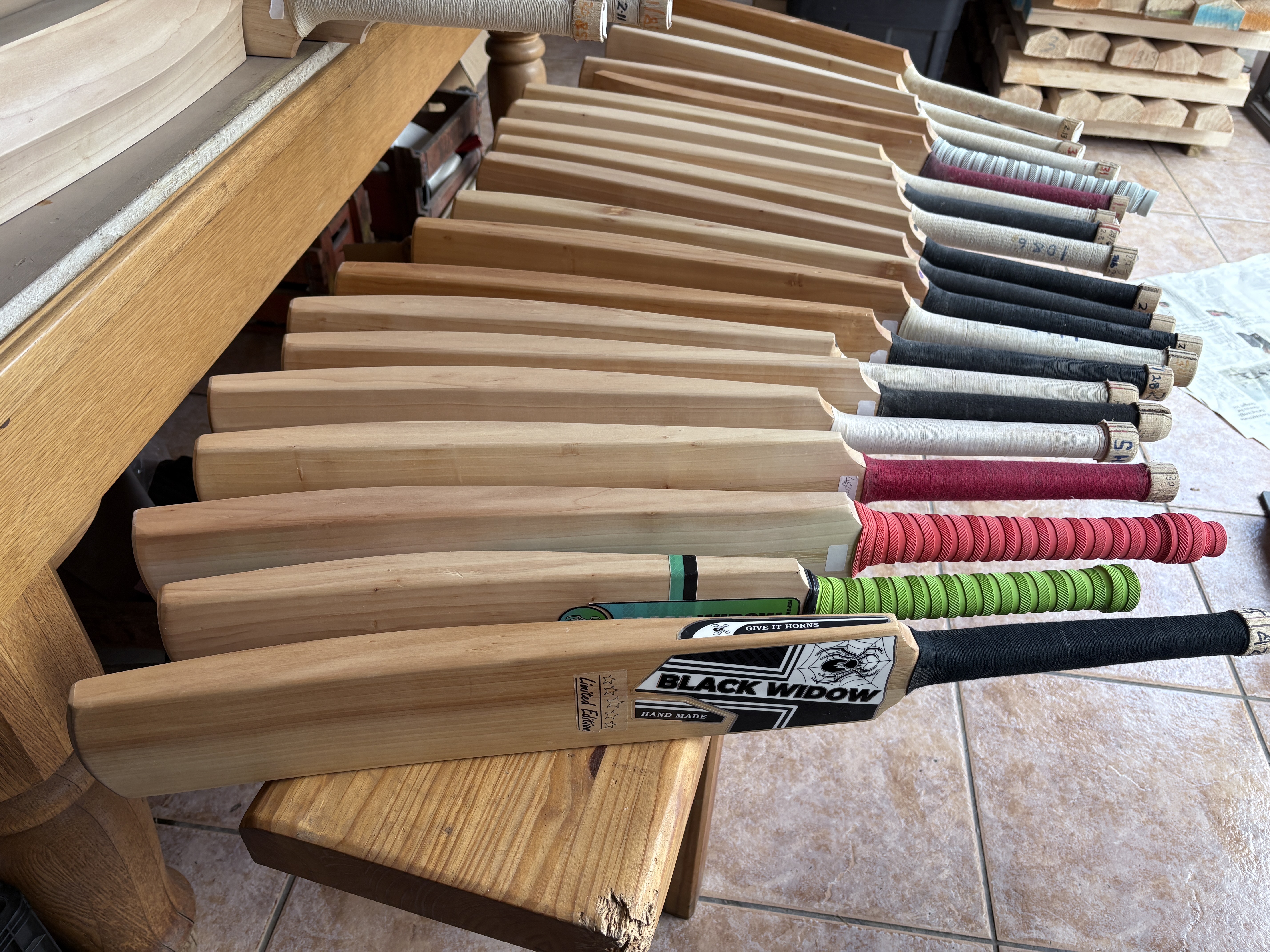It has been dubbed “the cricket bat emergency”, as the price of bats has skyrocketed over the past few years. According to the managing director of D&P Cricket, Paul Borst, a top bat from this leading manufacturer has “at least doubled” in price in the past 10 years.
But it’s not because of a shortage of willow, the wood used to make bats, as many have suggested. Rather, the global growth in the sport, largely facilitated by the boom of T20 cricket, has meant that an increasing number of companies are trying to have a bite of the cricket bat production pie, starting all the way from the willow.
Jeremy Ruggles, director at JS Wright & Sons, a 130-year-old, family-run agricultural business that cultivates English willow, has no concerns about the amount of wood available globally. Asked whether he had any concerns about future supply, he was adamant: “No, no, we’ve increased production this year. We’re looking for increases again year on year for the next few years.
“We have many more trees maturing in the next five or six years. We’ve planted more and more trees. So I’m hoping the price is going to come down a bit. Whether it will come down is another matter, but it should stabilise a lot anyway.”
There’s a good chance that the last cricket bat you picked up started its life as a Salix alba (variety caerulea) – the botanical name for the English willow – in JS Wright & Sons’ woodyard in Chelmsford, England. About 75% of the world’s cricket bats are made from the company’s wood.
Ruggles attributed the increase of prices throughout the manufacturing process to the “raw material price in the UK”.
“The price of trees – trees just cost more. There’s more competition for trees,” he said. This has meant that the best-quality cricket bat available in South Africa can cost upwards of R20,000.
Changing landscape
To say everything is as it was in the global game would be untrue. So much has changed in the past 20 years, and most of it stems from India’s appetite for the game.
“What’s changed cricket big time is the IPL [Indian Premier League],” said David van der Walt, the master craftsman behind Black Widow Manufacturing, which specialises in handcrafting quality English willow cricket bats and other cricket equipment.
Van der Walt is the foremost bat maker in South Africa. Black Widow is one of only three companies in the country that receive English willow clefts – raw blocks of wood – from JS Wright & Sons. The others are D&P Cricket and Brian Bands Sports.
“Suddenly, the interest in world cricket has gone through the roof and there’s massive demand for bats,” Van der Walt said.
Along with the rapid growth of the IPL, India has experienced one of the biggest middle-class expansions globally in recent years. According to Borst, it is another big factor in the increase of cricket bat prices.
/file/dailymaverick/wp-content/uploads/2025/10/IMG_9493.jpeg)
India is the biggest exporter of ready-made cricket bats in the world. The wood starts its life as a tree in England, from where it gets sent as a cleft to India. There it is turned into a cricket bat, which is then exported to the rest of the world.
South Africa receives a large quantity of these ready-made bats as well, despite having three local manufacturers that receive the same quality clefts from the same company in England.
“I was travelling to India back in 1999, 2000 and India made English willow bats, but mainly only for export. Very little was sold in India,” Borst said.
“Now, with the growth of the expat community out of Asia and the growth in the middle class in India, India can make English willow bats and sell all it has in India. There’s been a massive spike in demand based around the growth of wealth in India.
“There’s been an increased requirement for English willow, which has led to more demand for the trees, which has led to prices going up. And you see a reaction now.”
New companies
Indian manufacturers selling bats under their own brands have completely changed the cricket bat landscape. Half of South Africa’s Test batters use bats that are made by manufacturers in India.
Ryan Rickelton and Wiaan Mulder are with Sareen Sports Industries, Temba Bavuma is with Delux Sports Company and Tristan Stubbs is with Sunny Gold.
David Bedingham and Kyle Verreynne are the only two with the English brand Gray-Nicolls, which is one of fewer than a handful of cricket bat manufacturers worldwide that do their own manufacturing from scratch.
Most other companies, including popular brands like Kookaburra, have their cricket bats made in India and just plaster their own brand stickers on the bats. It’s an extremely common practice.
The cricket bats found in Sportsmans Warehouse in South Africa, for example, are mostly made in the same factories as Sunny Gold’s in India, which make about 400 bats a day. However, they are sold with different brands’ stickers on them.
Generational demands
The demand for new cricket bats from professional cricketers has increased dramatically as well, born from T20 and the power hitting that has come with it.
“Geoffrey Boycott probably had one new bat every three years,” said Borst, referring to the former English Test cricketer who started his career in the 1960s and was one of the country’s most renowned opening batsmen.
“Herschelle Gibbs maybe had four or five bats a year. Now, the modern equivalent, Virat Kohli, probably has 50 to 60 bats a year. The guys play more cricket. They practise more.
/file/dailymaverick/wp-content/uploads/2023/11/Craig-India-dominance-2.jpg)
“The introduction of the side-arm [ball thrower] for practice is undeniably affecting batting immeasurably because now I, as a 49-year-old, can throw to my son at 130km/h for a couple of hours. That never happened in the past. You’d never get that, and the bat takes the pounding.”
But bats have also been developed to hit the ball further and not to last long, like they were in the past. “The other factor is that bats are generally built for performance, not to last,” Borst said.
Van der Walt explained the process of extracting as much ping from the bat onto the ball. “They dry the timber out down to 8% so they can have them bigger and lighter, and then you can’t compress them as hard. They leave them massive, but also they don’t last. The bats will break.
“You can ask any top international player in the IPL – they probably break between 10 and 40 bats in a season.”
Climate change impact
Although the size and shape of bats have changed considerably, batters still want straight, narrow grains on the face of their bats, mainly for aesthetic reasons.
Trees growing faster means it’s harder to get the look that batters want. When eyeing a new bat, many cricketers look for narrow grains that run parallel to the handle down the face of the bat. This is despite wider grains not being a determining factor in how the ball will respond off the bat – although it does take longer to “knock in” the bat. It’s more a case of an aesthetic tradition that hasn’t changed.
/file/dailymaverick/wp-content/uploads/2025/10/IMG_9478.jpeg)
But with climate change, these bat specifications have become increasingly more difficult to achieve – England has experienced milder winters and longer growing periods.
The positive note is that instead of the traditional 20 years it used to take for the Salix alba caerulea to mature, it now takes about 15. But the trees have wider rings, which mean wider grains.
“Trees are growing faster, which obviously means wider grain because a dark and light area is a year’s growth, and more fertilisers in the soils and in the rivers also cause it to grow faster,” Borst said. “So the availability of narrower grains is less.”
Controlling the growth of the wood is out of the hands of those farming the trees, such as Ruggles. But there’s no shortage in the availability of these clefts of wood. DM
This story first appeared in our weekly Daily Maverick 168 newspaper, which is available countrywide for R35.





 The factory of David van der Walt of Black Widow Bats in Rondebosch, Cape Town. (Photo: Supplied)
The factory of David van der Walt of Black Widow Bats in Rondebosch, Cape Town. (Photo: Supplied)